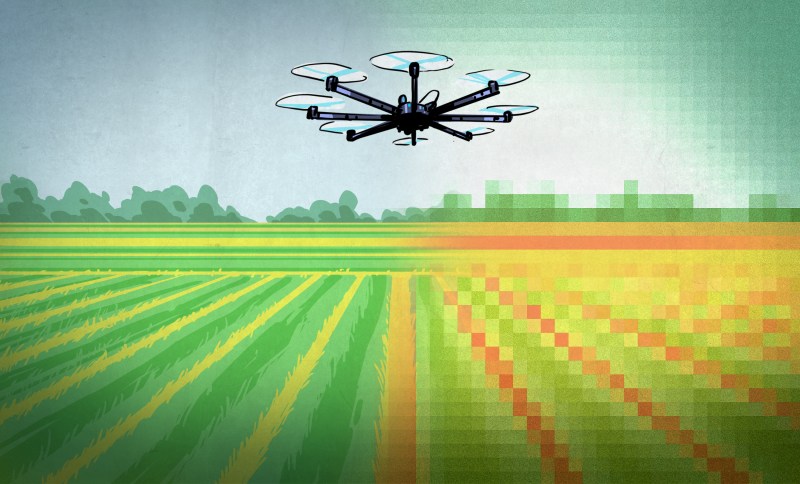
Good piece in Hackaday on how drones can revolutionize agriculture. Here's the start, but read here for the rest, including a deeper discussion on NDVI techniques.
Whether you call them UAVs (Unmanned Aerial Vehicles), UAS (Unmanned Aerial System), Drones, or something less polite – people are more familiar than ever with them. We’ll call them drones, and we’re not talking about the remote-controlled toy kind – we’re talking about the flying robot kind. They have sensors (GPS and more), can be given a Flight Plan (instructions on where to go), and can follow that plan autonomously while carrying out other instructions – no human pilot required. Many high-end tractors are already in service with this kind of automation and we’ve even seen automated harvesting assistance. But flying drones are small and they don’t plant seeds or pull weeds, so what exactly do they have to do with agriculture?
There are certain things that drones are very good at, and there are things in agriculture that are important but troublesome to do or get. Some of these things overlap, and in those spaces is where a budding industry has arisen.
Let’s cover what drones can offer and what growers can use, then dig into what is out there and happening over some fields right now.
These Things are Important to Farmers, but are Limited or Troublesome
Confirmation: Verifying that plants are growing where and when they should, and checking this as early and often as possible.
Early Detection of Problems: Detecting areas of poor growth and crop damage as early as possible, limiting impact and maximizing the chances of doing something about it.
Fertilizer Planning: A crop will never grow completely evenly, and choosing where to put fertilizer and how much to use based on plant density and health (instead of spreading it uniformly) can save significant money. This is called Variable Rate Application and anything that helps it get done more accurately saves money and increases crop yield.
Comments
Hydrogen will save the battery problem. Not sure if the doing enough wattage yet for say my project.
One is got to remember that one flight of 4:30 minutes does 2 hectares of land
If it's spraying the type of hill side I'm spraying it bets walking them
The amount of product is less, Over spray is eliminated
Returning to fix missed patches is a none event as the auto runs are so consistent.
It's not worth weed spraying unless your spreading seed after it.
With my set up you can change to a seed unit with in minutes.
So the time is now despite the power issues
Even paying 20k for hydrogen is still viable.
The spray drones are just not selling.
The biggest factor here in NZ is not the price, it's not the looks like candy and would break if I knocked it with the tractor.
The biggest factor for not selling is the learning curve to fly and fix.
It's like computers back in the day the only people who could use them was nerds, Now it's odd if someone isn't using one.
In turn drones will become common too and the syndrome at the moment regarding sales will disappear.
Hold on in there people, plays now will be players later.
Seems like automating one of those Yamaha copters for tasks like this makes a lot more sense than waiting around for multirotors to get some kind of magical battery and a 4000% increase in lift capacity for things like spraying. I wonder what it would take to put a Pixhawk on one of those?
https://youtu.be/2Xzz1UqtQVE
Check this out , at the moment it sprays, fertilises and can be changed to do any other job.
This shows some of the journey.
I don't agree Eric, I'm a farmer and drones are usefull for me, they help me to monitor crops, detect insect attacks specially in sunflowers that are horrible to walk and impossible to cover the hole field, detect weeds groups, begining diseases in little field places in different crops, drought better evaluation, Nitrogen precision aplication, etc.etc , you can do much quick and precise monitoring with a Drone, obious not with a toy that only fly 300mts during 10 mins.
I've worked with lots of US farmers and follow enough farmers on Twitter that collectively they probably own over 50,000 acres in the US Midwest. Nobody is using drones for anything more than glamour shots of their planting/harvesting/spraying applications. It's going to take quite a few seasons to make drone imagery useful for anything.
Rob, with the high winds we are experiencing this spring I have been looking more into trad heli for survey and mapping. I'll keep an eye on your developments!
My understanding is the Yamaha helis are manually flown, but I'm not sure that's true in all cases.
There are zero reasons not to automate the process, however. It just takes the desire to do it. However, most of the money and brains in this industry are putting their resources into multirotors, struggling to figure out how to get payload and range into an inefficient electric vehicle, when the solution to the problem is right there already.
elad , are those Yamaha rigs from 30 years ago automated?
Eventually agri drones will take off from top of the tractor, scan fields for crop health, real time stitch the results back to a display in the cab and return to land on the tractor. Perhaps from one of Remeir's Pixhawk tractors!
and yet most researches show ROI of less then 5%
as those things are done anyhow
and drones just not there yet
p.s
Yamaha been doing those things in japan for the last 3 decades